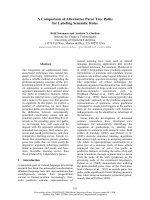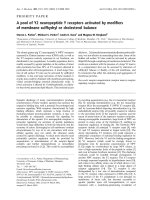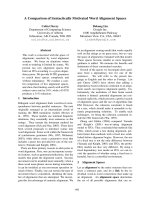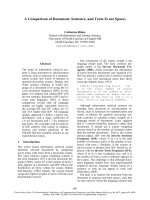Báo cáo y học: "A Comparison of Immuncapture Agglutination and ELISA Methods in Serological Diagnosis of Brucellosis"
Bạn đang xem bản rút gọn của tài liệu. Xem và tải ngay bản đầy đủ của tài liệu tại đây (303.51 KB, 5 trang )
Int. J. Med. Sci. 2011, 8
428
I
I
n
n
t
t
e
e
r
r
n
n
a
a
t
t
i
i
o
o
n
n
a
a
l
l
J
J
o
o
u
u
r
r
n
n
a
a
l
l
o
o
f
f
M
M
e
e
d
d
i
i
c
c
a
a
l
l
S
S
c
c
i
i
e
e
n
n
c
c
e
e
s
s
2011; 8(5):428-432
Research Paper
A Comparison of Immuncapture Agglutination and ELISA Methods in Sero-
logical Diagnosis of Brucellosis
Mehmet Özdemir
1
, Bahadır Feyzioğlu
2
, Muhammed Güzel Kurtoğlu
4
, Metin Doğan
2
, Hatice Türk Dağı
3
,
Şerife Yüksekkaya
4
, Recep Keşli
4
, Bülent Baysal
1
1. Department of Medical Microbiology, Selcuk University Meram Faculty of Medicine, Konya, Turkey
2. Medical Microbiology Laboratory, Karaman State Hospital, Karaman, Turkey
3. Medical Microbiology Laboratory, Batman State Hospital, Batman,Turkey
4. Medical Microbiology Laboratory, Konya Education and Research Hospital, Konya, Turkey
Corresponding author: Mehmet Özdemir MD, Department of Clinical Microbiology, Selcuk University Meram Medical
Faculty, TR-42080, Konya, Turkey. Tel: 0.332.2236856; Fax: 0332.2236181; e-mail:
© Ivyspring International Publisher. This is an open-access article distributed under the terms of the Creative Commons License (
licenses/by-nc-nd/3.0/). Reproduction is permitted for personal, noncommercial use, provided that the article is in whole, unmodified, and properly cited.
Received: 2011.01.24; Accepted: 2011.06.16; Published: 2011.07.13
Abstract
Background: Different serological tests are used in serologic diagnosis of brucellosis. The
most widely used of these are Standard Tube Agglutination and Coombs anti-brucella
tests. Whereas ELISA Ig M and Ig G tests have been in use for a long time, immuncapture
agglutination test has been recently introduced and used in serological diagnosis. The
aim of this study was to compare diagnostic values of ELISA Ig M and Ig G and im-
muncapture agglutination tests with Coombs anti-brucella test.
Methods: Sera from 200 patients with presumptive diagnosis of brucellosis were in-
cluded into the study. Coombs anti-brucella test, ELISA Ig M and Ig G tests and Im-
muncapture test were investigated in these sera. Then, sensitivity, specificity, negative
predictive and positive predictive values were calculated.
Results: Sensitivity, specificity, negative predictive and positive predictive values were
found to be 90,6 %, 76,3 %, 94,2 %, and 65,9 % respectively for the Immuncapture test,
whereas they were found to be 73,7 %, 58,9 %, 84,2 %, and 42,8 % for Ig G and 72,2 %, 67,8
%, 85,2 %, and 48,7 % for Ig M. The Immuncapture test was found to be compatible with
ELISA Ig M and Ig G tests but it was statistically incompatible with Coombs anti-brucella
test.
Conclusions: Immuncapture agglutination test yields similar results to those of Coombs
anti-brucella test. This test is a useful test by virtue of the fact that it determines blocking
antibodies in the diagnosis and follow-up of brucellosis.
Key words: Brucellosis, immuncapture, ELISA, IgG, IgM, serologic diagnosis
INTRODUCTION
Brucellosis is a zoonotic infection that is trans-
missible from animals to humans and it affects vari-
ous organs and leads to different clinical symptoms. It
progresses with symptoms and signs such as high
temperature, sweating and pain in the joints but it is
also a disease that leads to clinical pictures imitating
rheumatic and psychiatric diseases. Brucella is a gram
negative staining, immotile, non spore forming, aero-
bic, microaerophile and coccobacillus bacteria that has
microcapsules when it is newly separated from the
Ivyspring
International Publisher
Int. J. Med. Sci. 2011, 8
429
organism. Isolation of the microorganism from the
culture ensures diagnosis of the disease but sensitivity
of this method is correlated 30-90 % with the stage of
the disease (1). When the culture is found negative,
investigation of classic serologic tests and antibodies
occupy an important place in diagnosis of brucellosis.
Antibodies begin to form 2 weeks after the beginning
of disease. Those who engage in animal husbandry
may have normal antibodies at 1/80 titer. Im-
munglobulin (Ig) M type antibodies appear in one
week and reach a peak in three months. Ig G anti-
bodies, on the other hand, appear in three weeks and
reach a peak in six to eight weeks. Coombs test is
needed to investigate blocking antibodies. Dilutions
need to be performed in very high ratios in order to
remove occurrence of prezone (2). In recent years, the
immuncapture agglutination test, which is based on
sandwich ELISA system, has been introduced. In this
method, microwell is covered with Coombs antibod-
ies against human origin Ig G, Ig M and Ig A anti-
bodies. This method is brucella agglutination test that
occurs in microwell and performed with Coombs an-
tiserum and determines the three antibodies that form
against brucella.
The purpose of this study is to compare the di-
agnostic values of Immuncapture agglutination and
ELISA methods, which are used for the diagnosis of
brucellosis with reference to Coombs test.
MATERIAL AND METHOD
Sera samples from 200 patients with presump-
tive diagnosis of brucellosis which were sent to Cen-
tral Microbiology Laboratory of Selcuk University
Meram Faculty of Medicine from various clinics were
included in the study and kept at -70ºC until per-
forming laboratory study. Coombs anti-brucella test
(Vircell, S.L., Spain), ELISA Ig G and Ig M (Vircell,
S.L., Spain) and Brucellacapt (Vircell, S.L., Spain) tests
were studied simultaneously in these sera.
Brucellacapt agglutination test was conducted in
the following manner: All reactives were brought to
room temperature (18-25C). 95 l serum diluents was
put in the first microwell in the microplate whereas 50
l serum diluents was put in others. 5 l serum was
pipetted into the first microwell and mixed. 50 l was
taken from this microwell and diluted in order and
finally 50 l was removed. 50 l brucella antigen was
added to all microwell. The plate was covered with
the protective cover in the box so that the liquid in the
microwell would not dry up and the required reaction
would take place and incubated at 37C for 18-24
hours. The results were assessed visually as the first
microwell being at 1/160 titration. Since the antigens
fall to the bottom without attaching to the wall if
brucella antibodies do not exist, they were seen in the
form of blue dots in the serum being studied. The blue
dot was assessed to be negative whereas homogenous
blue appearance was considered to be positive.
1/320 and higher values were taken to be posi-
tive for Brucellacapt whereas values above the cut-off
value were considered to be positive for ELISA. The
results were read on spectrophotometer at 450 nm
absorbance. The results obtained via the three meth-
ods were recorded.
The results were analyzed by using the paired t
test method on SPSS for Windows 13.0 software. This
study was approved by the local institutional ethics
committee of the Selcuk University Meram Faculty of
Medicine.
RESULTS
The immuncapture results in the 200 sera sam-
ples were classified as negative, 1/320 positive, 1/640
positive, 1/1280 positive, 1/2560 positive, 1/5120
positive and 1/10240 positive. ELISA results, on the
other hand, were divided into positive and negative
and a distribution table was structured according to
the results of immuncapture (Table 1). A total of 144
samples were determined to be positive for immun-
capture and 122 for Ig M, and 123 for Ig G. Sensitivity,
specificity, negative predictive and positive predictive
values for ELISA and immuncapture test are given in
Table 2. The compatibility of the results of the three
tests was analyzed on the basis of evaluation and sta-
tistical evaluation with reference to Coombs test. The
groups emerged as Group I (ELISA), Group II
(Coombs) and Group III (Brucellacapt). According to
the results of the paired t-test conducted at 95 % con-
fidence interval between Group I and Group II, t val-
ue was found to be -0,84, and correlation 0,439. Ac-
cordingly, Groups I and II were not statistically com-
patible. According to the results of the paired t-test
conducted at 95 % confidence interval between Group
II and Group III, t value was found to be -1,26, and
correlation 0,551. Accordingly, the values between
Group II and Group III were found to be statistically
compatible. According to the results of the paired
t-test conducted at 95 % confidence interval between
Group I and Group III, t value was found to be 0,32,
and correlation 0,397. Accordingly, the values be-
tween Group I and Group III were found to be statis-
tically compatible.
Sensitivity, specificity, negative predictive and
positive predictive values were found to be 90,6 %,
76,3 %, 94,2 %, and 65,9 % respectively for the Im-
muncapture test, whereas they were found to be 73,7
%, 58,9 %, 84,2 %, and 42,8 % for Ig G and 72,2 %, 67,8
%, 85,2 %, and 48,7 % for Ig M respectively.
Int. J. Med. Sci. 2011, 8
430
Table 1. Distribution of the results of Immuncapture and ELISA tests
Immuncapture
ELISA Ig G ELISA Ig M ELISA Ig M and G
Positive Negative Positive Negative Positive Negative
Negative 56 23 33 18 38 34 22
1 / 320 44 35 9 23 21 37 7
1 / 640 18 13 5 16 2 17 1
1 / 1280 37 18 19 27 10 30 7
1 / 2560 14 11 3 12 2 13 1
1 / 5120 21 19 2 18 3 20 1
1 / 10240 10 4 6 8 2 8 2
Number of Positive sample 144 123 77 122 78 159 41
Table 2. Sensitivity, specificity, negative predictive and positive predictive values of tests used in comparison
Test Sensitivity Spesifity PPD NPD
ELISA 90,0 66,7 91,1 63,6
Immuncapture 90,6 76,3 94,2 65,9
IgG 73,7 58,9 84,2 42,8
IgM 72,2 67,8 85,2 48,7
PPD: positive predictive value
NPD: negative predictive value
DISCUSSION
Brucella agglutination tests have an important
role in the diagnosis of brucellosis. Main antigenic
structure which is imported in the diagnosis of bru-
cellosis is the smooth lipopolysaccharide structure of
the antigen cell surface. Brucella, which is a gram
negative bacterium, has a lipopolysaccharide struc-
ture in the outer membrane in S colony phase and has
a surface that is in contact with the outer surface. This
smooth lipopolysaccharide structure plays a very
important role in agglutination tests. Ig M and G type
antibodies that form against this structure are identi-
fied through agglutination tests. ELISA test which is
among these tests and makes it possible to determine
the type of antibody (3).
Obtaining negative results in agglutination tests
is a common phenomenon. One of the reasons for this
is blocking antibodies. One of the methods used to
show existence of blocking antibodies is the Coombs
test. Brucellacapt test, on the other hand, is an im-
muncapture agglutination test which is based on
sandwich ELISA method.
In a study conducted by Orduna et al. (4) on the
serum samples from 82 patients diagnosed with bru-
cellosis, 157 patients presumed to have brucellosis
and 412 control patients, 82 patients were found to be
positive with brucellacapt test and Coombs test in
initial sera whereas 75 patients were found to be neg-
ative with standard tube agglutination (SAT). When
1/160 and higher titers were taken to be positive,
sensitivity of brucellacapt test, Coombs anti brucella
test and SAT are respectively 95.1 %, 91.5 % and 65.8
%. The correlation of brucellacapt test and Coombs
anti brucella test was found to be r =0,866 in their
study. This correlation was found to be 0,551 in our
study and lower in comparison. Orduna et al. found that
since the brucellacapt could determine all three of the
antibodies and blocking antibodies that form against
brucella, the titers that it has determined were higher
in number than STA and Coombs methods has higher
sensitivity and specificity (4).
In a study conducted by Casao
et al. on 123 sera
samples, the compatibility ratio between the brucel-
lacapt test and the Coombs test was found to be cor-
related (r=0.14), (2). The correlation coefficient was
found to be higher in our study (r=0,551).
Ardic et al. (5) compared immuncapture and
STA with reference to Coombs test. When 1/160 and
higher titres were considered positive, they found
sensitivity of the brucellacapt test was 97.3 %, its
specificity was 55.6 %, its positive predictive value
was 90 % and its negative predictive value was 83.3 %.
When they took the threshold value to be 1/320, they
calculated these values to be 100 %, 59.1 %, 88.6 % and
100 % respectively. The Coombs test was taken as the
reference test in our study, and the sensitivity,
specificity and positive and negative predictive values
Int. J. Med. Sci. 2011, 8
431
of the other two methods were calculated and their
compatibility with one another was investigated
statistically.
In a comparative study conducted by Prado et al
(6), immuncapture agglutination test (Brucellacapt),
SAT and Coombs anti-Brucella test were compared
with Ig G, Ig A and Ig M ELISA tests. It was deter-
mined that as diagnostic tests, the sensitivity and
specificity of immuncapture-agglutination test (Bru-
cellacapt) and Coombs anti-brucella were similar to
one another; in the follow-up of the treatment, the
antibody titers determined via these tests were close
to one another and it was concluded that they were
well correlated. Though we tested similar methods in
our study, the exclusion of ELISA Ig A test from our
study was a shortcoming.
In a study conducted by Gomez et al., on the
other hand, a direct correlation was observed between
the Brucellacapt test and Coombs test in negative and
positive sera samples. Similar results were obtained in
positive sera between the Brucellacapt test and the
Coombs test titers within the range of 1 or 2 dilutions
(7).
In another study conducted by Serra et al., sta-
tistical difference was not observed between the Bru-
cellacapt and Coombs tests in terms of sensitivity and
specificity in the diagnosis and follow-up of brucello-
sis and it was concluded that the results were similar
in the follow-up of patients with brucellosis (8).
Araj noted that it was not uncommon for agglu-
tination tests to yield false negative results in patients
with neurobrucellosis and claimed that the ELISA
method was the most reliable method in these pa-
tients (9). However, agglutination and Coombs tests
have been used as standard tests in the diagnosis of
brucellosis and their correlation with clinics were
quite good. Whether the ELISA test is the best method
in the treatment of patients with neurobrucellosis or
not needs to be investigated with similar studies.
In a similar study conducted by Memish et al.,
which included 68 patients with brucellosis and 70
control group, sensitivity and specificity were found
to be 45.5 % and 97.1 % for Ig M and 79 % and 100 %
for Ig G respectively (10). When the two ELISA Ig
positivity were evaluated together, sensitivity and
specificity were found to be 94.1 % and 97.1 % re-
spectively. Evaluation of two Ig’s together rather than
one by one increases their sensitivity and specificity
values. The Ig G and Ig M sensitivities found in our
study were higher in comparison to the study in
question but specificity is lower. This situation may be
related with the phase of the brucella infection.
In a study conducted by Ciftci et al. (11) on the
basis of blood culture results, sensitivity was calcu-
lated to be 97.1 % for ELISA Ig G and 71.4 % for ELISA
Ig M. They found the compatibility of ELISA Ig M and
Ig G test results with STA at the level of 75.3 % for Ig
M and 84.4 % for Ig G. These results were high in
comparison to our results but the number of samples
is lower. The fact that blood culture and Ig A were
also investigated using the ELISA method in that
study is its advantage.
While specific Ig M rises alone or with Ig A in
acute brucellosis, Ig G rises alone or with Ig A in
chronic brucellosis (12). The sensitivity of Ig M ELISA
test was 80 % in acute cases whereas the sensitivity of
Ig G and Ig M together was determined to be between
90 and 100 % (13)
.
Therefore, these two antibodies
should be evaluated together in patients presumed to
have brucellosis.
The ELISA method has higher positivity, higher
titers and the advantage of identifying different clas-
ses of antibodies in comparison to other agglutination
methods. Different results may be obtained depend-
ing on the nature of anti-globulin. This situation has
an effect on the sensitivity, specificity and ultimately
applicability of the method (12,14).
ELISA tests are
relatively costlier tests in comparison to agglutination
tests that require equipment and experience. In a
comparative study conducted by Araj et al, it was
argued that the ELISA method should be preferred
because in chronic and complicated cases, STA and
Rose Bengal tests might miss a serious portion of
positive cases (15).
Coombs test is necessary for an investigation of
blocking antibodies in the serologic diagnosis of bru-
cella infection. Among the tests that can be used alone
or together with other tests, immuncapture aggluti-
nation and ELISA Ig M and Ig G tests, which are
based on sandwich ELISA system, are standardized
tests that have high diagnostic value and can be used
interchangeably. Titer is found higher in the immun-
capture method because Ig G, Ig M, Ig A antibodies
and blocking antibodies are identified.
Acknowledgement
This study was supported by a scientific research
fund of Selçuk University School of Medicine.
Conflict of Interest
The authors have declared that no conflict of in-
terest exists.
References
1. Gotuzzo E, Cellillo C. Brucella. In: Gorbach SL, Bartlett JG,
Blacklow NR, eds. Infectious Diseases; 2
nd
Edition. Philadelph-
ia: WB Saunders Co. 1992: 1513-21.
Int. J. Med. Sci. 2011, 8
432
2. Casaoa MA, Navarroa E, Solerab J. Evaluation of Brucellacapt
for the diagnosis of human brucellosis. Journal of Infection
2004; 49: 102–108.
3. Clavijo E, Diaz R, Anguita A, Garcia A, Pinedo A, Smith HL.
Comparison of a Dipstick Assay for Detection of Brucel-
la-Specific Immunoglobulin M Antibodies with Other Tests for
Serodiagnosis of Human Brucellosis. Clinical And Diagnostic
Laboratory Immunology 2003;4:612-5.
4. Ordun A, Almaraz A, Prado A, Purıfıcacıo M, Gutıerrez N,
Garcıa-Pascual A, Duen A, Cuervo M, Abad R, Herna´Ndez B,
Lorenzo B, Bratos AM, Rodrıguez Torres A. Evaluation of an
immunocapture-agglutination test (Brucellacapt) for serodiag-
nosis of human Brucellosis. J Clin Microbiol 2000;38:4000-5.
5. Ardic N, Ozyurt M, Sezer O, Erdemoglu A, Haznedaroglu T.
Comparison of Coombs and immunocapture-agglutination
tests in the diagnosis of brucellosis. Chin Med J
2005;118(3):252-4.
6. Prado A, Gutierrez P, Duenas A. Serological follow-up of bru-
cella patients using an immunocapture-agglutination test
(Brucellacapt), Coombs anti-Brucella and LPS-ELISA tests.
Clinical Microbiology and Infection 2001; 7(supp 1):394.
7. Gomez MC, Rosa C, Geijo P, Escribano MA. Comparative study
of the Brucellacapt test versus the Coombs test for Brucella.
Enferm Infec Microbiol Clin. 1999;17: 283-5
8. Serra J, Velasco J, Godoy P, Mendoza C. Can the Brucellacapt
test be substituted for the Coombs test in the diagnosis of hu-
man brucellosis? Enferm Infec Microbiol Clin 2001;19:202-5.
9. Araj GF. Enzyme-Linked Immunosorbent Assay, not Aggluti-
nation, is the test of choice for the diagnosis of serodiagnosis
Neurobrucellosis. Clinical Infectious Diseases 1997;25(4):939.
10. Memish ZA, Almuneef M, Mah MW, Qassem LA, Osobad AO.
Comparison of the Brucella Standard Agglutination Test with
the ELISA IgG and IgM in patients with Brucella bacteremia.
Diagnostic Microbiology and Infectious Disease 2002;
44:129–32.
11. Ciftci C, Öztürk F, Öztekin A, Karaoğlan H, Saba R, Gültekin M,
Mamıkoğlu L. Comparison of serologic tests which are used in
the diagnosis of Brucellosis. Mikrobiol Bült 2005;39:291-9.
12. Alışkan H. Diagnostic value of Culture and serological methods
in human brucellsis. Mikrobiol Bult 2008;42:185-95.
13. Ariza J, Pellicer T, Pallares R, Foz A, Gudiol F. Specific antibody
profile in human brucellosis. Clin Infect Dis 1992;14:131-40.
14. Osaba AO, Balkhy H, Memish Z. Diagnostic value of Brucella
ELISA IgG and IgM in bacteremic and non-bacteremic patients
with brucellosis. J Chemother. 2001 Apr;13:54-9
15. Araj GF, Kattar MM, Fattouh LG, Bajakian KO, Kobeissi SA.
Evaluation of The PANBIO Brusella immunglobulin G and IgM
enzyme-linked immunosorbent assays for diagnosis of human
bruscellosis. Clin Diagn Lab Immunol 2005;12:1334-5.









